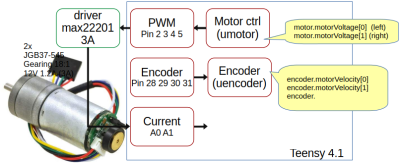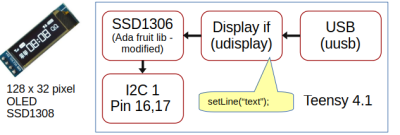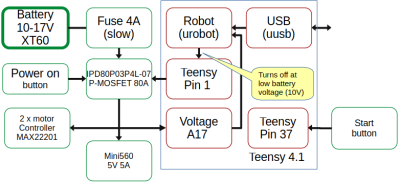Basebot modules
Back to Basebot
Module description
Main code
The main code is in basebot_6.ino (sometimes renamed to basebot_6.cpp).
The code is based on the Arduino environment. Here the normal C-main function is hidden. But setup() is called first, followed by an endless loop that called loop().
Setup
The setup() function is like this and initializes all support modules:
void setup() // INITIALIZATION
{ // to be able to print to USB interface
Serial.begin(12000000);
// initialize sensors, safety and display
robot.setup(); // alive LED, display and battery
motor.setup(); // motor voltage
encoder.setup(); // motor encoders to velocity
imu2.setup(); // gyro and accelerometer - include tilt angle
}
Loop
The loop() function:
void loop ( void )
{ // init sample time
uint32_t nextSample = 0;
while ( true )
{ // main loop
// get time since start in microseconds
uint32_t us = micros();
// loop until time for next sample
if (us > nextSample) // start of new control cycle
{ // advance time for next sample
nextSample += sampleTimeUs;
// read sensors
imu2.tick();
encoder.tick();
// advance test sequence (default is wait for start button)
testSequence();
// make control actions
controlUpdate();
// give value to actuators
motor.tick();
// support functions
robot.tick(); // measure battery voltage etc.
display.tick(); // update O-LED display
}
usb.tick(); // listen to incoming from USB
}
}
Support modules
Motor
The motor action is implemented in src/umotor.cpp in function motorSetAnchorVoltage().
Motor voltage is translated to a PWM at 65kHz, where the average value corresponds to the set motor voltage. Current battery voltage is taken into consideration.
PWM = motorVoltage * MAX_PWM/(battery_voltage - voltageLoss)
The motor controller has a minimum pulse width. A minimum PWM is added to compensate if the motor voltage is not zero. The minimum corresponds to 0.4V motor voltage.
The motor current uses a HAL sensor ACS714; the zero is about 3.3V/2. Other nearby components may influence the values and should be used with caution.
The encoder uses an interrupt for every value edge. The velocity is estimated based on the timing difference from the last edge before this sample period to the newest edge.
Encoder values are available as
encoder.encoder[0..1] A, unsigned 32-bit, counter of all edges detected. Positive is counterclockwise. encoder.motorVelocity[0..1] Motor velocity (float) in radians per second before the gearbox. Positive is counterclockwise. encoder.gear is the gearbox ratio (9.68) encoder.pulsPerRev is the number of edges on a motor revolution (48)
If no edge is detected in this sample period, the time since the last edge is used, but only if this time gives a slower estimate.
The encoder estimates are implemented in src/uencoder.cpp.
Gyro and accelerometer
The sensor chip is an MPU9250. Sensor values are extracted from the chip at every sample time, but the values may be repeated if the sample time is faster than 1 ms.
The values are available as
imu2.gyro[0..2] for rotation velocity around axis x,y,z in degrees per second. imu2.acc[0..2] for acceleration along x,y,z. X is forward, Y is left, and Z is up.
The values are not compensated for the mounted position. Open the robot to see the device mounting.
(implemented in uimu2.cpp)
Display
The small O-LED display has one line (at the top) that the user can set.
It is implemented in src/udisplay.cpp.
Power and start button
Power is managed in an attempt to avoid destroying the LiPo batteries.
The power is turned off when the battery voltage drops below 10 Volts (assuming a three-cell Lipo battery).
To turn the power back on, press the power button. The power will stay on regardless of the battery voltage as long as the button is pressed.
When the USB is connected and the power is off, the USB 5V will power the robot. Even the motors can run (slowly) on USB power.
The start button is available on pin 37. Value is high, when button is pressed.



